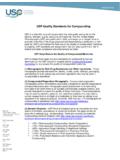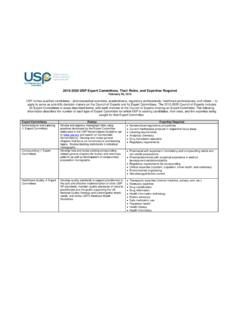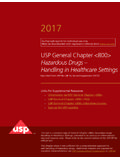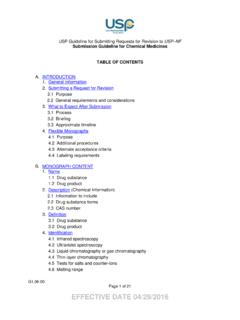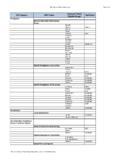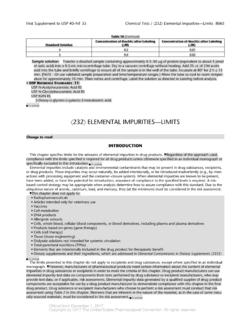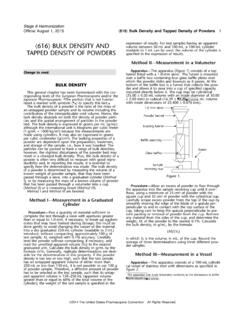Transcription of 905 UNIFORMITY OF DOSAGE UNITS USP34
1 Stage 6 HarmonizationOfficial December 1, 2011 905 uniformity of dosage units1 The test for Content UNIFORMITY is required for all DOSAGE 905 uniformity of dosage forms not meeting the above conditions for the FWeightFVariation ( USP34 )UNITST able 1. Application of Content UNIFORMITY (CU) and WeightVariation (WV) Tests for DOSAGE FormsDose & Ratio ofDrug SubstanceChange to read: 25<25mgmg orThis general chapter is harmonized with the correspond-and<25%Dosageing texts of the European Pharmacopoeia and the Japanese 25%FormTypeSubtypePharmacopoeia.
2 Portions of the general chapter text that arenational USP text, and are not part of the harmonized text,UncoatedWVCUT abletsare marked with symbols (FF) to specify this In this chapter, unit and DOSAGE unit ensure the consistency of DOSAGE UNITS , each unit in aSuspension,batch should have a drug substance content within a nar-emulsion,row range around the label claim. DOSAGE UNITS are definedor gelCUCUas DOSAGE forms containing a single dose or a part of a doseSolutionsWVWVS oftof drug substance in each unit. The UNIFORMITY of dosageunits specification is not intended to apply to suspensions,Single com-Solids in sin-emulsions, or gels in unit-dose containers intended for ex-ponentWVWVgle-unitternal, cutaneous term UNIFORMITY of DOSAGE unit is defined as thefreeze-degree of UNIFORMITY in the amount of the drug substancedried in fi-among DOSAGE UNITS .
3 Therefore, the requirements of thisnalMultiplechapter apply to each drug substance being comprised incontainerWVWV compo- DOSAGE UNITS containing one or more drug substances, un-OthersCUCU nentsless otherwise specified elsewhere in this inThe UNIFORMITY of DOSAGE UNITS can be demonstrated byunit-doseeither of two methods, Content UNIFORMITY or FWeightFVaria-containerstion (see Table 1). The test for Content UNIFORMITY of prepa-Fand intorations presented in DOSAGE UNITS is based on the assay ofsoft cap-the individual content of drug substance(s) in a number ofsulesFWVWV DOSAGE UNITS to determine whether the individual content isOthersCUCU within the limits set.
4 The Content UNIFORMITY method may beapplied in all test for FWeightFVariation is applicable for the follow-ing DOSAGE forms:Change to read:(W1)Solutions enclosed in unit-dose containers and into softcapsules;CONTENT UNIFORMITY (W2)Solids (including powders, granules, and sterile solids)that are packaged in single-unit containers and containSelect not fewer than 30 UNITS , and proceed as follows forno active or inactive added substances;the DOSAGE form designated.(W3)Solids (including sterile solids) that are packaged in sin-Where different procedures are used for assay of the prep-gle-unit containers, with or without active or inactivearation and for the Content UNIFORMITY test, it may be neces-added substances, that have been prepared from truesary to establish a correction factor to be applied to thesolutions and freeze-dried in the final containers and areresults of the to indicate this method of preparation.
5 AndSolid DOSAGE Forms Assay 10 UNITS individually using(W4)Hard capsules, uncoated tablets, or film-coated tablets,an appropriate analytical method. Calculate the acceptancecontaining 25 mg or more of a drug substance compris-value (see Table 2).ing 25% or more, by weight, of the DOSAGE unit or, inLiquid nor Semi-Solidn2S( USP34 ) DOSAGE Forms nAssay 10the case of hard capsules, the capsule contents, exceptunits individually using an appropriate analyticalthat UNIFORMITY of other drug substances present ( USP34 ) Carry out the assay on the amount of well-lesser proportions is demonstrated by meeting the re-mixed material that is removed from an individual containerquirements for Content Pharmacopoeia and Japanese Pharmacopoeia text not acceptedby the United States Pharmacopeia.
6 Alternatively, products listed in item (4)above that do not meet the 25mg/25% threshold limit may be tested foruniformity of DOSAGE UNITS by Mass Variation instead of the Content Uniform-ity test if the concentration relative standard deviation (RSD) of the drugsubstance in the final DOSAGE UNITS is not more than 2%, based on processvalidation data and development data, and if there has been regulatory ap-proval of such a change. The concentration RSD is the RSD of the concentra-tion per DOSAGE unit ( w/w or w/v), where concentration per DOSAGE unitequals the assay result per DOSAGE unit divided by the individual DOSAGE unitweight.
7 See the RSD formula in Table ( USP34 ) 2011 The United States Pharmacopeial ConventionAll Rights 6 Harmonization2 905 uniformity of dosage UnitsOfficial December 1, 2011in conditions of normal use, and express the results as de-in which the terms are as defined in Table dose. Calculate the acceptance value (see Table 2).Calculation of Acceptance Value Calculate the accep-tance value by the formula:Table 2 VariableDefinitionConditionsValueMean of individual contents (c1,c2, , cn), expressed as a per-Xcentage of the label claimc1, c2, , cnIndividual contents of the unitstested, expressed as a percentageof the label claimnSample size (number of UNITS in asample)If n = 10, then k = constantIf n = 30, then k = standard deviationRSDR elative standard deviation (the100s/Xsample standard deviation ex-pressed as a percentage of themean)If X , thenM = X (AV = ks)M (case 1)
8 To be applied when TReference value = X < , then(AV = X + ks)M = X > , then(AV = X + ks)M = XM (case 2) to be applied when TReference valueIf X T, then(AV = ks)> = X < , then(AV = X + ks)M = T%If X >T, then(AV = X T + ks)Acceptance value (AV)general formula:(Calculations are specified abovefor the different cases.)L1 Maximum allowed acceptanceL1 = unless otherwise speci-valuefied 2011 The United States Pharmacopeial ConventionAll Rights 6 HarmonizationOfficial December 1, 2011 905 uniformity of dosage Units3 Table 2 (Continued)VariableDefinitionConditionsV alueL2 Maximum allowed range forOn the low side, no DOSAGE unitL2 = unless otherwise speci-deviation of each DOSAGE unitresult can be less thanfiedtested from the calculated value[1 ( )(L2)]M, while on theof Mhigh side no DOSAGE unit resultcan be greater than [1 +( )(L2)]M.
9 (This is based onan L2 value of )TTarget content per DOSAGE unit atthe time of manufacture, ex-pressed as a percentage of thelabel claim. nUnless otherwisestated, T is per cent, or Tis the manufacturer s approvedtarget content per ( USP34 )Liquid DOSAGE Forms Accurately weigh the amount ofliquid that is removed from each of 10 individual containersin conditions of normal use. If necessary, compute theFWEIGHTF VARIATION equivalent volume after determining the density. Calculatethe drug substance content in each container from the massCarry out an assay for the drug substance(s) on a repre-of product removed from the individual containers and thesentative sample of the batch using an appropriate analyti-result of the assay.
10 Calculate the acceptance method. This value is result A, expressed as percent oflabel claim (see Calculation of Acceptance Value). Assume thatCalculation of Acceptance Value Calculate the accep-the concentration (weight of drug substance per weight oftance value as shown in Content UNIFORMITY , except that thedosage unit) is uniform. Select not fewer than 30 dosageindividual contents of the UNITS are replaced with the indi- UNITS , and proceed as follows for the DOSAGE formvidual estimated contents defined or Film-Coated Tablets Accurately weigh 10c1, c2.
